EMD: GP30
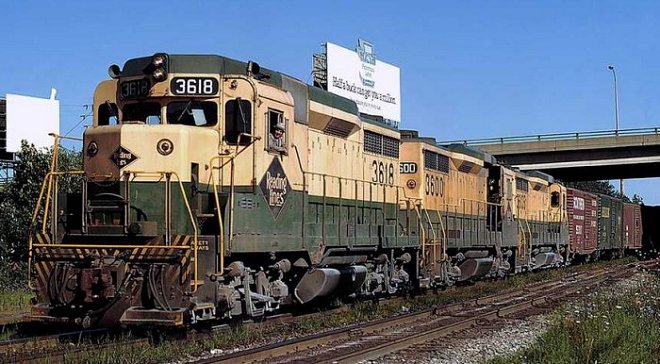
Built in response to General Electric's U25B locomotive, the GP-30 was EMD's initial "second-generation" diesel locomotive. Introduced by EMD in late 1961, the Reading placed an order for 20 units, and was the first railroad to do so - thus, the Reading's GP-30s were the first production units of this type in the US! The Reading had already placed an order for GP-20 locomotives, but switched to GP-30s prior to taking delivery, having seen the considerable improvements built into the newer model at the GP-30's official "debut" at the GM Technical Center in Michigan. As would become common practice for the frugal railroad's financing of second-generation power, the Reading traded in the entire fleet of FT A and B cab units toward the purchase of the GP-30s, and durable parts from the FTs such as trucks and generators were remanufactured for use in the new locomotives. Reading officials believed the road switcher design would offer greater versatility than the FTs, and their 2250 horsepower rating meant that two units could effectively do the work of three 1500HP units.
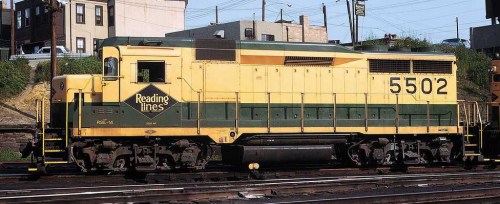 The GP-30s began arriving on the Reading in April, 1962, and the entire fleet was in service by the end of July. When they arrived, they made a dramatic entrance onto the property with their yellow and green paint, inspired by the EMD demonstrator scheme. The new locomotives were a stark contrast to the utilitarian look of the Pullman Green switchers and road switchers and the dark (though stylish) appearance of the various cab unit classes. This new look was intended to show the public (and presumably customers and stockholders) that the railroad was indeed "modern" in its thinking. Indeed, the facts that the Reading dieselized early and moved in the direction of road switchers rather than maintaining an aging fleet of cab units was a testament to the road's progressive nature.
The GP-30s began arriving on the Reading in April, 1962, and the entire fleet was in service by the end of July. When they arrived, they made a dramatic entrance onto the property with their yellow and green paint, inspired by the EMD demonstrator scheme. The new locomotives were a stark contrast to the utilitarian look of the Pullman Green switchers and road switchers and the dark (though stylish) appearance of the various cab unit classes. This new look was intended to show the public (and presumably customers and stockholders) that the railroad was indeed "modern" in its thinking. Indeed, the facts that the Reading dieselized early and moved in the direction of road switchers rather than maintaining an aging fleet of cab units was a testament to the road's progressive nature.
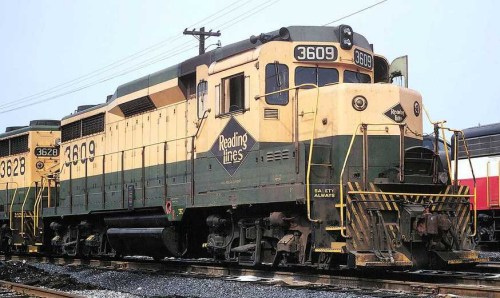 When delivered, the GP-30s were numbered 5501-5520; however, as the units were overhauled in 1963 and 1964, they were renumbered 3600-3619 to correspond to the numbering conventions used by the B&O/C&O. Approximately at the same time, the units lost their yellow frame stripes, with the lower half of the locomotive being painted solid green, creating the paint scheme that would be used on most Reading motive power until the 1970s.
When delivered, the GP-30s were numbered 5501-5520; however, as the units were overhauled in 1963 and 1964, they were renumbered 3600-3619 to correspond to the numbering conventions used by the B&O/C&O. Approximately at the same time, the units lost their yellow frame stripes, with the lower half of the locomotive being painted solid green, creating the paint scheme that would be used on most Reading motive power until the 1970s.
From an operational standpoint, the GP-30s were based at Rutherford when delivered, and were used exclusively on crossline freights between Allentown, PA and Hagerstown, MD, most often running in paired sets of two. In 1964, after additional second-generation locomotives arrived on the property (Alco Century 424s and EMD GP-35s), the GP-30s were released for duty across the rest of the Reading system, and could be seen mated with any other type of power working in mainline freight service up to the Conrail era. The GP-30s were historic for the Reading in a number of ways - They ushered in the era of second-generation diesel motive power, and their colorful paint scheme helped garner publicity for the Reading as it tried to cast itself to shippers as a modern, progressive company on the leading edge of rail transportation.
MODELING NOTES: There are several interesting points to note when modeling the GP-30s. The first is considering the proper road number, in the 5500 or 3600 series, depending on the time being modeled. Your choice of year/number also will answer the question of whether your model should have the yellow frame stripe. With regard to lettering, compare the two photos below. Looking at the left photo of #3603, you will note that the Reading diamond on the short hood is larger than that placed on #3610, visible at right. The large diamond was applied to 3600 and 3603 after delivery, while the rest of the class received the smaller diamond. Finally, take note of the positioning of the air horns. These units used a 3-chime Leslie air horn, but the curved profile of the engine cab and roof made mounting difficult. To solve the problem, two bells were placed on the engineer's side, with the third placed on the fireman's side, as can be seen in the photos on this page. In the photo at the top of the page, you can see how the firecracker radio antenna is mounted on the fireman's side directly in front of the air horn.
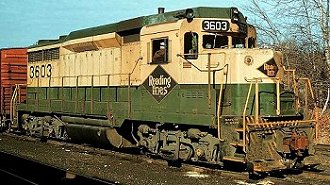 |
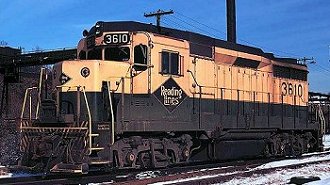 |
Did You Know?
Downloads
 A variety of Reading Company operations related documents, etc. that may be of use in your modeling efforts.
A variety of Reading Company operations related documents, etc. that may be of use in your modeling efforts.
 A variety of Reading Company operations paperwork, such as train orders, clearance forms, etc. that will help you operate your Reading layout in a prototypical manner.
A variety of Reading Company operations paperwork, such as train orders, clearance forms, etc. that will help you operate your Reading layout in a prototypical manner.
 Public Timetables, Employe Timetables, and Rulebooks that provide much useful operational information.
Public Timetables, Employe Timetables, and Rulebooks that provide much useful operational information.
 Signs, billboards, and other FREE goodies for your use. We ask only that you help spread the word about The Reading Modeler!
Signs, billboards, and other FREE goodies for your use. We ask only that you help spread the word about The Reading Modeler!

